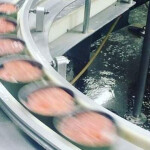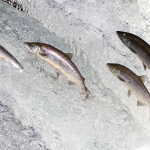By analyzing the elemental makeup of shrimp flesh, a group of researchers has been able to identify the shrimp’s country of origin, according to a recent study.
The analysis technique – called elemental profiling – could, with further refinement, aid importers, customs officials and retailers as they seek to trace seafood back to its source.
In the study, a group of scientists led by the World Wildlife Fund (WWF) differentiated the origin of headless shell-on Pacific white shrimp from two areas of Thailand, three provinces of Vietnam and India. They could identify the country of origin with 98 percent accuracy, though tracing back to the particular state or province was less accurate.
Elemental profiling could help locate the origin of a seafood product, and in turn assist with efforts to combat environmental degradation and worker abuse on farms by giving importers a clearer picture of the shrimp’s provenance.
Such a method of narrowing the geographic origin of a product could add another layer of oversight to aquaculture operations, according to Aaron McNevin, the director of aquaculture at WWF, and a co-author on the study.
“More importantly, this level of oversight is not based on word of mouth or written records; it’s based on the chemistry of the shrimp,” McNevin told SeafoodSource.
Such traceability largely isn’t possible in mainstream markets today, McNevin said. Generally, long global supply chains and hard-to-enforce rules make it difficult to trace the origin of seafood products.
“In aquaculture – aside from farmed salmon, some high-end species and products from vertically integrated production – I would say the status of traceability is poor,” McNevin said.
Importers and others in the seafood industry have to rely on records provided by exporters to identify the origin of a product. Such records are hard to verify and can easily be manipulated, allowing for mislabeling and fraud.
And the murky traceability obstructs efforts to ensure environmental stewardship, worker welfare and food safety.
Elemental profiling involves analyzing the elements that make up a material or species. For the study, the researchers examined 23 elements in shrimp, such as arsenic, boron, selenium, silicon, tin, magnesium, potassium, and sulfur. The elements included micro-nutrients, macro-nutrients and non-essential trace elements.
The researchers then linked the ratio of the elements in the shrimp to certain places where the shrimp are produced. Other industries, notably winemaking, use a similar process to determine product origin.
The technique had already proven successful on other seafood products; Claude Boyd, a professor of aquaculture and aquatic sciences at Auburn University and co-author on the new study, profiled catfish and shrimp in the southeastern United States. Doing the same with major shrimp farming countries was the next logical step, Boyd said.
“This research demonstrated that we also have some ability to differentiate shrimp from provinces and states in countries,” he said in a statement, adding that country-level identification was more accurate.
Elemental profiling should work to pinpoint the origins of all types of farmed species, McNevin said. Identifying the origin of wild-caught species might also be possible, but more challenging.
“I think it would be difficult with highly migratory species. It would probably be more possible to distinguish between wild and farmed products,” McNevin said.
The technique does have its limitations. Currently, it can’t help seafood sellers avoid sourcing from environmentally harmful shrimp farms.
“Knowing what country an aquaculture product comes from does not provide any information on how a specific farm is operated,” McNevin said.
It also can’t yet be used determine the origin of shrimp that is processed, packaged and sold at retail outlets. If researchers can determine that, the World Wildlife Fund would advocate that elemental profiling be used as a supply chain oversight method.
“We need to determine if the profiles we have developed for shrimp taken from farms will be able to be picked up in shrimp sold at stores,” McNevin said.
Americans, on average, eat about four pounds of shrimp per year, more than 80 percent of which is imported. In 2014, the U.S. imported 568,000 tons of shrimp worth USD 6.7 billion (EUR 6 billion) from 39 countries.
The private sector is already expressing interest in elemental profiling, and is requesting profiles of shrimp samples, McNevin said. A single sample might cost USD 70 to 80 (EUR 63 to 72), but higher volumes would reduce the price.
“I think there is cautious optimism [but] more research is necessary to validate the work on a larger scale,” McNevin said.






